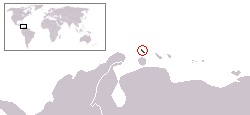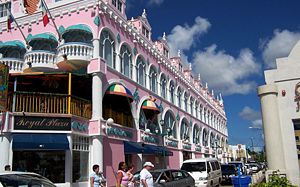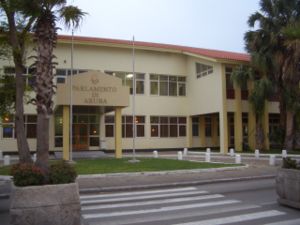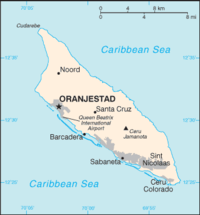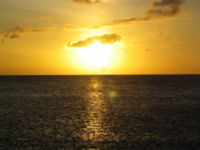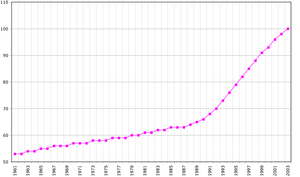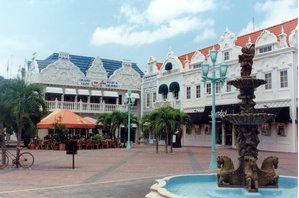Aruba
2008/9 Schools Wikipedia Selection. Related subjects: Americas; Countries
| Aruba | ||||||
|---|---|---|---|---|---|---|
|
||||||
| Motto: "One happy Island" | ||||||
| Anthem: Aruba Dushi Tera |
||||||
|
|
||||||
| Capital (and largest city) |
Oranjestad |
|||||
| Official languages | Dutch, Papiamento1 | |||||
| Demonym | Aruban | |||||
| Government | Constitutional monarchy | |||||
| - | Monarch | Queen Beatrix | ||||
| - | Governor | Fredis Refunjol | ||||
| - | Prime Minister | Nelson O. Oduber | ||||
| - | Vice-Prime Minister | Marisol Lopez-Tromp | ||||
| Independence | from Netherlands Antilles | |||||
| - | Date | 1 January 1986 | ||||
| Area | ||||||
| - | Total | 193 km² 74.5 sq mi |
||||
| - | Water (%) | negligible | ||||
| Population | ||||||
| - | 2006 estimate | ± 112,000 ( 195th) | ||||
| - | Density | 571/km² ( 18th) 1,479/sq mi |
||||
| GDP ( PPP) | 2007 estimate | |||||
| - | Total | $2.400 billion ( 182nd) | ||||
| - | Per capita | $23,831 ( 32nd) | ||||
| Currency | Aruban florin ( AWG²) |
|||||
| Time zone | AST ( UTC-4) | |||||
| Internet TLD | .aw | |||||
| Calling code | +297 | |||||
| 1 | Spanish and English also spoken. | |||||
| 2 | Arubaanse Waarde Geld. | |||||
Aruba is a 33-kilometre (21 mi)-long island of the Lesser Antilles in the southern Caribbean Sea, 27 km (17 mi) north of the Paraguaná Peninsula, Falcón State, Venezuela. A country within the Kingdom of the Netherlands, Aruba has no administrative subdivisions. Unlike much of the Caribbean region, Aruba has a dry climate and an arid, cactus-strewn landscape. This climate has helped tourism as visitors to the island can reliably expect warm sunny weather. It has a land area of 193 km² (75 sq mi) and lies outside the hurricane belt.
History
Aruba's first inhabitants were the Caquetios Amerindians from the Arawak tribe, who migrated there from Venezuela to escape attacks by the Caribs. Fragments of the earliest known Indian settlements date back from 1,000 AD. The Caquetios remained more tied to South America than the Caribbean, due to Aruba's distance from other Caribbean islands and sea currents which made canoe travel to other islands difficult.
Europeans first learned of Aruba when Amerigo Vespucci and Alonso de Ojeda came across it in August 1499. Vespucci in one of his four letters to Lorenzo di Pierfrancesco de' Medici described his voyage to the islands along the coast of Venezuela. He wrote about an island where most trees are of brazilwood and, from this island, he went to one ten leagues away, where they had houses built as in Venice. In another letter he described a small island inhabited by very large people, which the expedition thought was not inhabited.
Aruba was colonized by Spain for over a century. The Cacique or Indian Chief in Aruba, Simas, welcomed the first priests in Aruba and received from them a wooden cross as a gift. In 1508, Alonso de Ojeda was appointed as Spain's first Governor of Aruba, as part of "Nueva Andalucia."
Another governor appointed by Spain was Juan Martinez de Ampues. A "cédula real" decreed in November 1525 gave Ampués, factor of Española, the right to repopulate the depopulated islands of Aruba, Curaçao and Bonaire. The natives under Spanish rule enjoyed more liberty than the average northern European farmer of the period.
In 1528, Ampues was replaced by a representative of the "House of Welser". Aruba has been under Dutch administration since 1636, initially under Peter Stuyvesant. Stuyvesant was on a special mission in Aruba in November and December 1642. Under the Dutch W.I.C. administration, as "New Netherland and Curaçao" from 1648 to 1664 and the Dutch government regulations of 1629, also applied in Aruba. The Dutch administration appointed an Irishman as "Commandeur" in Aruba in 1667.
Great Britain occupied Aruba from the years 1799 to 1802, and from 1805 to 1816.
In August 1806, General Francisco de Miranda and a group of 200 freedom fighters on their voyage to liberate Venezuela from Spain stayed in Aruba for several weeks.
In 1933 Aruba sent its first petition for Aruba's separate status and autonomy to the Queen.
During World War II, together with Curaçao the then world-class exporting oil refineries were the main suppliers of refined products to the Allies. Aruba became a British protectorate from 1940 to 1942 and a US protectorate from 1942 to 1945. On February 16, 1942, its oil processing refinery was attacked by a German submarine ( U-156) under the command of Werner Hartenstein. Miraculously, the mission failed. The U-156 was later destroyed by a US plane as the crew was sunbathing; only one survived. In March 1944, Eleanor Roosevelt briefly visited American troops stationed in Aruba. In attendance were: His Excellency, Dr. P. Kasteel, the Governor of Curaçao, and his aide, Lieutenant Ivan Lansberg; Rear Admiral T. E. Chandler and his Aide, Lieutenant W. L. Edgington; Captain Jhr. W. Boreel and his aide, Lieutenant E. O. Holmberg; and the Netherlands aide to Mrs. Roosevelt, Lieutenant Commander v.d. Schatte Olivier.
The island's economy has been dominated by five main industries: gold mining, phosphate mining (The Aruba Phosphaat Maatschappij), aloe export, petroleum (The Lago Oil & Transport Company and the Arend Petroleum Maatschappij Shell Co.), and tourism.
Politics
As a Constituent Country of the Kingdom of the Netherlands, Aruba's politics take place within a framework of a 21-member Parliament and an eight-member Cabinet. The governor of Aruba is appointed for a six-year term by the monarch, and the prime minister and deputy prime minister are elected by the Staten (or "Parlamento") for four-year terms. The Staten is made up of 21 members elected by direct, popular vote to serve a four-year term.
Together, the State of the Netherlands, the State of the Netherlands Antilles, and the State of Aruba form a Commonwealth. As they share the same Dutch citizenship, these three countries still also share the Dutch passport as the Kingdom of the Netherlands passport. As Aruba and the Antilles have small populations, the two countries had to limit immigration. To protect their population, they have the right to control the admission of Netherlands nationals. There is the supervision of the admission and expulsion of Netherlands nationals and the setting of general conditions for the admission and expulsion of aliens.
The move towards independence
In August 1947, Aruba presented its first " Staatsreglement (constitution)", for Aruba's "status aparte" as the status of a completely separate and autonomous state within the Kingdom of the Netherlands, under the authority of the Dutch crown. This is the same as in the UK's Statute of Westminster, an equal status of the Dominion Parliaments with the British Parliament, where the Dominions were under the authority of the crown and not of the government of the UK.
In November 1955, J. Irausquin of Aruba's PPA political party spoke in front of the United Nations Trust Committee. He ended his speech saying that in the future there will be changes to come.
In 1972, at a conference in Suriname, Betico Croes (MEP) proposed a "sui-generis" Dutch Commonwealth of four states: Aruba, the Netherlands, Suriname and the Netherlands Antilles, each with its own nationality. Mr. C. Yarzagaray, a parliamentary member representing the AVP political party, proposed a referendum for the people of Aruba to determine Aruba's separate status or "Status Aparte" as a full autonomous state under the crown. He proclaimed: "Aruba shall never accept a federation and a second class nationality."
Betico Croes worked in Aruba to inform and prepare the people of Aruba for independence. In 1976, a committee appointed by Croes introduced the national flag and anthem as the symbols of Aruba's sovereignty and independence, and he also set 1981 as a target for Aruba's independence. In March of 1977, the first Referendum for Self Determination was held with the support of the United Nations and 82% of the participants voted for independence.
The Island Government of Aruba assigned the Institute of Social Studies in The Hague to prepare a study of Aruba's independence, which was published in 1978, titled "Aruba en Onafhankelijkheid, achtergronden, modaliteiten en mogelijkheden; een rapport in eerste aanleg".
At the conference in the Hague in 1981, Aruba's independence was then set for the year 1991. In March 1983, based on the Referendum, Aruba finally reached an official (de-colonization) agreement with the State of the Netherlands, the State of the Netherlands Antilles and the Island Governments, for Aruba's Independence, first becoming an autonomous country and member state of the Kingdom of the Netherlands, with its own constitution, unanimously approved and proclaimed in August 1985, and after an election held for Aruba's first parliament, Aruba officially became a member state of the Kingdom of the Netherlands on January 1, 1986, with full independence set for 1996, within a Dutch Commonwealth of sovereign states. This achievement is largely due to the late Betico Croes and the political support of other nations like the USA, Panama, Venezuela and various European countries. Croes was later proclaimed "Libertador di Aruba" after his tragic death in 1986.
In 1990, movement toward independence was postponed upon the request of Aruba's Prime Minister, Nelson O. Oduber. The article scheduling Aruba’s complete independence was rescinded in 1995, although the process can begin again after a referendum.
Since January 1, 1986, the Kingdom has consisted of three completely autonomous, constitutionally equal countries: the Netherlands, the Netherlands Antilles, and Aruba.
Although the “equal status” of the countries is explicitly laid down in the preamble to the Charter, which states "..considering that they have expressed freely their will to establish a new constitutional order in the Kingdom of the Netherlands, in which they will conduct their internal interests autonomously and their common interests on a basis of equality, and in which they will accord each other reciprocal assistance, have resolved by mutual consent", in practice, the Netherlands has considerably more power than either the Netherlands Antilles or Aruba.
Law
Legal jurisdiction lies with a Gerecht in Eerste Aanleg ( Court of First Instance) on Aruba, a Gemeenschappelijk Hof van Justitie voor de Nederlandse Antillen en Aruba ( Common Court of Justice of the Netherlands Antilles and Aruba) and the Hoge Raad der Nederlanden (Supreme Court of Justice of the Netherlands).
Education
Aruba’s educational system, patterned after the Dutch system, provides for education at all levels. The Government finances the national education system, except for private schools, such as the International School of Aruba (ISA), which finance their own activities. The percentage of money earmarked for education is higher than the average for the Caribbean/Latin American region.
Arubans benefit from a strong primary school education. A segmented secondary school program includes vocational training (VMBO), basic education (MAVO), college prep (HAVO) and advanced placement (VWO).
Higher education goals can be pursued through the Professional Education program (EPI), the teachers college (IPA) as well as through the University of Aruba (UA) which offers bachelors and masters programs in law, finance and economics and hospitality and tourism management. Since the choice for higher education on the island itself is limited, many students choose to study abroad in countries in North America, South America as well as Europe.
There are 68 schools for primary education, 12 schools for secondary education and 5 Universities.
Geography
Aruba is a generally flat, riverless island in the Leeward Antilles island arc of the Lesser Antilles. Aruba is renowned for its white, sandy beaches on the western and southern coasts of the island, relatively sheltered from fierce ocean currents. The northern and eastern coasts, lacking this protection, are considerably more battered by the sea and have been left largely untouched by humans. The interior of the island features some rolling hills, the better two of which are called Hooiberg at 165 meters (541 ft) and Mount Jamanota, the highest on the island at 188 metres (617 ft) above sea level. Oranjestad, the capital, is located at .
To the east of Aruba are Bonaire and Curaçao, two island territories which form the southwest part of the Netherlands Antilles; Aruba and these two Netherlands Antilles islands are sometimes called the ABC islands.
The isothermal temperature of Aruba's pleasantly tropical marine climate attracts tourists to the island all year round. Temperature varies little from 28 °C (82 °F), moderated by constant trade winds from the Atlantic Ocean. Yearly precipitation barely reaches 500 mm (19.7 in), most of it falling in late autumn.
Most tourist hotels are located on the leeward side of the island, providing better weather and enjoyment of beaches and ocean.
Economy
Aruba enjoys one of the highest standards of living in the Caribbean region; the low unemployment rate is also positive for Aruba. About three-quarter of the Aruban gross national product is earned through tourism or related activities. Most of the tourists are from Venezuela and the United States (predominately from eastern and southern states), Aruba's largest trading partner. Before the "Status Aparte", (a separate completely autonomous country/state within the Kingdom), oil processing was the dominant industry in Aruba despite expansion of the tourism sector. Today, the influence of the oil processing business is minimal. The size of the agriculture and manufacturing sectors also remains minimal.
The G.D.P. per capita for Aruba is calculated to be $23,831 in 2007; among the highest in the Caribbean and the Americas.
Deficit spending has been a staple in Aruba's history, and modestly high inflation has been present as well. Recent efforts at tightening monetary policy are correcting this and will have its first balanced budget in 2009. Aruba receives some development aid from the Dutch government each year, which will cease in 2009 as part of a deal (signed as "Aruba's Financial Independence") in which the Netherlands gradually reduces its financial help to the island each successive year. The Aruban florin is pegged to the United States dollar, with a fixed exchange rate where 1.79 Florin equals 1 U.S. dollar.
In 2006 the Aruban government has also changed several tax laws in order to further reduce the deficit. Direct taxes have been converted to indirect taxes as proposed by the IMF. A 3% tax has been introduced on sales and services, while income taxes have been lowered and revenue taxes for business reduced with 20%. The government compensated workers with 3.1% for the effect that the B.B.O. would have on the inflation for 2007. The inflation on Aruba in 2007 was 8,7%.
Aruba has the third largest seawater desalinization plant in the world after Saudi Arabia and Curaçao.
Demographics
Aruba is situated in the deep southern part of the Caribbean. Because of almost no rainfall, Aruba was saved from plantation and the economics of the slave trade.
Aruba's population is estimated to be 80% mestizo and 20% other ethnicities. Arawaks spoke the "broken Spanish" which their ancestors had learned on Hispaniola. The Dutch took control almost two centuries after the Spanish, and left the Arawaks to farm and graze livestock, and used the island as a source of meat for other Dutch possessions in the Caribbean. The Arawak heritage is stronger on Aruba than on most Caribbean islands. Although no full-blooded Aboriginals remain, the features of the islanders clearly indicate their genetic Arawak heritage . Most of the population is descended mostly from Arawak, and to a lesser extent Spanish, Italian and Dutch and a few French, British and African ancestors.
Recently there has been substantial immigration to the island from neighboring American and Caribbean nations, possibly attracted by the higher paid jobs. In 2007, new immigration laws were introduced to help control the growth of the population by restricting foreign workers to a maximum of 3 years residency on the island.
Culture
On March 18 Aruba celebrates its National Day. In 1976, Aruba presented its National Anthem (Aruba Dushi Tera) and Flag.
The origins of the population and location of the island give Aruba a mixed culture. Dutch influence can still be seen, as in the celebration of " Sinterklaas" on December 5 and 6 and other national holidays like April 30, when in Aruba and the rest of the Kingdom of the Netherlands the Queen's birthday or "Dia di La Reina" ( Koninginnedag) is celebrated.
Christmas and New Year are celebrated with the typical music and songs of gaitas for Christmas and the Dande for New Year, and the "ayaca", the "ponchi crema" and "ham", and other typical foods and drinks. Millions of dollars worth of fireworks are burnt at midnight on New Year's.
On January 25, Betico's Croes birthday is celebrated.
The holiday of Carnival is also an important one in Aruba, as it is in many Caribbean and Latin American countries, and, like Mardi Gras, that goes on for weeks. Its celebration in Aruba started, around the 1950s, influenced by the inhabitants from the nearby islands (Venezuela, St Vincent, Trinidad, Barbados and Amquilla) who came to work for the Oil refinery. Over the years the Carnival Celebration has changed and now starts from the beginning of January till the Tuesday before Ash Wednesday with a large parade on the last Sunday of the festivities (Sunday before Ash Wednesday).
In June there is the celebration of the "Dia di San Juan", with the song of "Dera Gai".
Tourism from the United States has recently also increased the visibility of American culture on the island, with such celebrations as Halloween and Thanksgiving Day in November.
Religion also has its influences; the days of Ascension and Good Friday are also two holidays on the island.
According to the Bureau Burgelijke Stand en Bevolkingsregister (BBSB), as of 2005 there are ninety-two different nationalities living on the island.
Language
Language can be seen as an important part of island culture in Aruba. The cultural mixture has given rise to a linguistic mixture known as Papiamento, the predominant language on Aruba. The two official languages are the Dutch language and Papiamento. Papiamento is a language that has been evolving through the centuries and absorbed many words from other languages like Dutch, English, diverse African dialects, and most importantly, from Portuguese and Spanish. However, like many islands in the region, Spanish is also often spoken. English has historical connections (with the British Empire) and is known by many; English usage has also grown due to tourism. Other common languages spoken based on the size of their community are Portuguese, Chinese, German and French. The latter is offered in high school and college, since a high percentage of Aruban students continue their studies in Europe.
In recent years, the government of Aruba has shown an increased interest in acknowledging the cultural and historical importance of its native language. Although spoken Papiamento is fairly similar among the several Papiamento-speaking islands, there is a big difference in written Papiamento. The orthography differs per island and even per group of people. Some are more oriented towards the Portuguese roots and use the equivalent spelling (e.g. "y" instead of "j"), where others are more oriented towards the Dutch roots.
In a book The Buccaneers of America first published in 1678, is stated by eyewitness account that the Indians on Aruba spoke "Spanish". The oldest government official statement written in Papiamento dates from 1803.
Aruba has four newspapers published in Papiamento: Diario, Bon Dia, Solo di Pueblo and Awe Mainta and two in English : Aruba Today and The News. Aruba also has 18 Radio Stations (2 AM and 16 FM) and three local Television stations (Tele-Aruba, Aruba Broadcast Company and Star Television).
Infrastructure
Aruba's Queen Beatrix International Airport is located near Oranjestad. This airport has daily flights to various cities across the United States, to San Juan, Puerto Rico; Miami, Florida; Chicago, Illinois; Philadelphia and Pittsburgh Pennsylvania; Houston, Texas; Atlanta, Georgia; Charlotte, North Carolina; Washington DC; New York, and Boston, Massachusetts. It also connects Aruba with Canada and South America, with daily flights to the international airports of Venezuela, Colombia, Peru, Brazil, Germany, France, Spain, England and most of Europe through the Schiphol Airport in the Netherlands. Direct flight from Italy will start in November 2008.
According to the Aruba Airport Authority, in 2005 almost 1.7 million travelers used the airport, of which 61% were Americans.
U.S. Immigration and Nat. Services (INS) full pre-clearance in Aruba has been in effect since February 1, 2001 at the Queen Beatrix Airport and since 2008, the only island to have this service for private flights. Since 1999, the US defense department established a Forward Operating Location at the airport.
Utilities on the island
Electricity is produced by the Water- en Energiebedrijf Aruba (WEB) N.V. The total power generating capacity of the steam turbines amounts to 149 megawatts. There is also a 22 megawatt gas turbine as a backup unit, while a 6.5 MW diesel generator serves as an emergency unit. WEB N.V. produces an average of 60 MW, which together with a contracted supply from the refining company, is sufficient to comply with the average demand of 77 MW.
WEB N.V. delivers electricity to the distribution company N.V. Electriciteit-Maatschappij Aruba (Elmar). Electricity is supplied at a 60-hertz frequency, and at 127 and 220 volts. Consumption of electricity has increased steadily since 1986 from 219,000 MW·h to 759,336 MW·h in 2005.
Water: Potable industrial water is produced from seawater by the Water- en Energiebedrijf Aruba (WEB) N.V., the world's second largest desalination plant. The total installed desalination capacity of the water plant (Multi Stage Flash) units is 42,000 metric tons per day . Average daily consumption in 2005 was about 37,043 metric tons.
Places of interest
|
|
|
|
* Collapsed September 2, 2005


